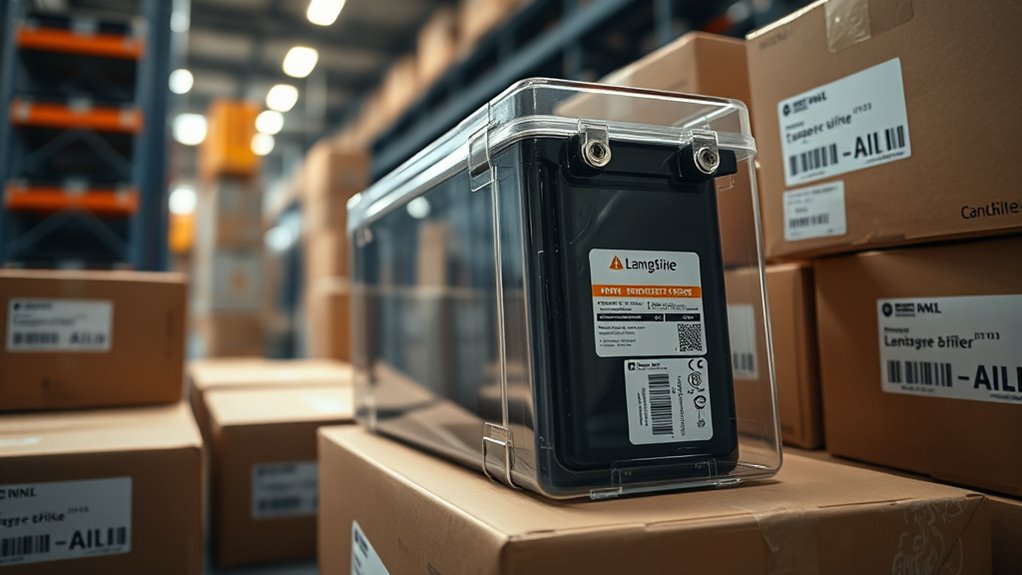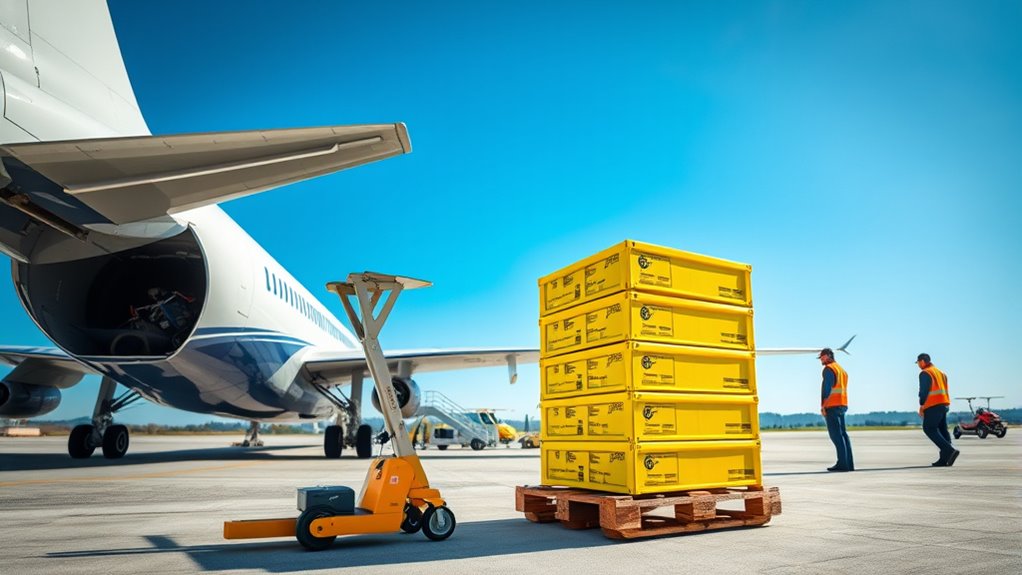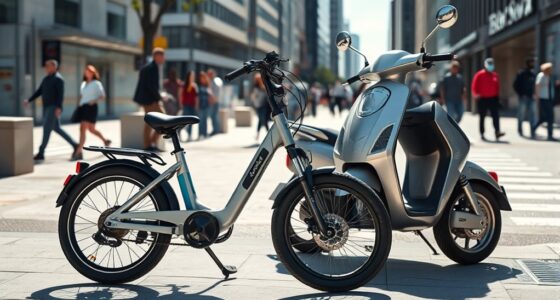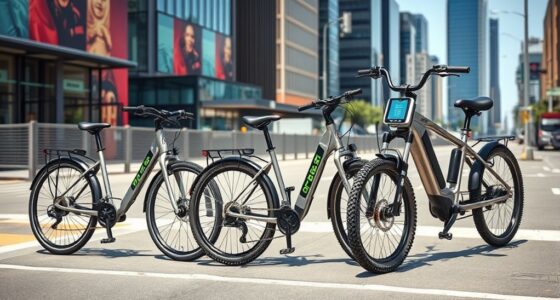When shipping or flying with e-bike batteries, you must follow IATA and international safety rules. Batteries under 100Wh are usually fine in carry-on luggage, but larger ones between 100Wh and 160Wh need airline approval. Always protect batteries from damage, use proper packaging, and keep them in cabin luggage for safety. Ensuring compliance helps prevent delays and safety hazards. Keep going, and you’ll discover the essential steps to transport your batteries securely and legally.
Key Takeaways
- Lithium-ion batteries up to 100Wh are permitted in carry-on luggage; larger batteries require airline approval.
- Batteries must be properly packaged, individually protected, and kept in carry-on to reduce fire risk.
- Follow IATA and international shipping standards for labeling, documentation, and safe packaging of batteries.
- Batteries over 160Wh are generally prohibited on passenger aircraft; verify size and approval before travel.
- Proper preparation ensures compliance, safety, and smooth transport of e-bike batteries according to ground and air regulations.

Shipping and flying with e-bike batteries can be tricky because these lithium-ion cells are considered hazardous materials. As a result, understanding the rules around battery safety and airline policies becomes vital to guarantee your batteries arrive safely and comply with regulations. Airlines and shipping carriers treat lithium-ion batteries with caution due to their potential fire risk, especially if damaged or improperly packed. Before you travel or ship, you need to familiarize yourself with specific guidelines to prevent delays, fines, or confiscation.
Battery safety is the top priority when it comes to transporting e-bike batteries. You must verify that the batteries are in good condition, with no visible damage, leaks, or corrosion. Proper packaging is essential — they should be protected from short circuits and physical damage. Typically, this means keeping the batteries in their original packaging or insulating their terminals with tape. If you’re carrying multiple batteries, each one should be individually protected and packed in a way that prevents contact with metal objects or other batteries. When flying, most airlines require that lithium-ion batteries be carried in your carry-on luggage rather than checked baggage, because cabin crews are better equipped to respond quickly in case of a fire. This is a direct consequence of airline policies that prioritize passenger safety; keeping batteries close allows for immediate action if necessary.
Verify batteries are undamaged and pack individually to ensure safety during air travel.
Airline policies regarding e-bike batteries can be strict, but they’re generally consistent across carriers. Typically, batteries up to 100Wh are allowed in carry-on luggage without special approval. For batteries between 100Wh and 160Wh, airline approval is usually required. Batteries exceeding 160Wh are generally prohibited on passenger aircraft, except in specific cases like for medical devices. Always check with your airline well in advance of your flight to understand their particular rules. Some airlines might have additional requirements, such as requiring you to declare your batteries or use specific packaging. Ignoring these policies can lead to denied boarding or confiscation, so it’s worth verifying before you get to the airport.
In addition to airline policies, international regulations like those from IATA (International Air Transport Association) set standards for battery shipping. These guidelines emphasize not only battery safety but also proper labeling, packaging, and documentation. If you’re shipping e-bike batteries via courier, you’ll need to follow these regulations carefully to avoid delays or legal issues. Proper understanding of battery classifications and their corresponding handling requirements is essential for compliance. When you combine knowledge of airline policies with adherence to international shipping standards, you reduce the risk of complications and guarantee your e-bike batteries are transported securely and legally. Ultimately, taking the time to understand and follow these rules guarantees a smoother journey, whether you’re flying with your batteries or sending them across the world.
Frequently Asked Questions
Are There Different Regulations for Lithium-Ion and Lithium-Polymer Batteries?
Yes, there are different regulations for lithium-ion and lithium-polymer batteries. You need to guarantee each battery has proper battery certification to meet regulatory compliance. Lithium-ion batteries often have stricter packaging and labeling rules due to their higher energy density. Lithium-polymer batteries may have slightly relaxed rules, but you still must follow specific handling and shipping requirements. Always check current regulations to stay compliant and avoid shipment delays.
How Do Size and Capacity Affect Shipping Restrictions?
Did you know that batteries with a capacity over 100Wh are subject to stricter restrictions? Your battery size and capacity limits directly impact shipping regulations. Larger batteries, especially those exceeding 160Wh, often require special approval and packaging. Smaller batteries, under 100Wh, usually face fewer restrictions. Always check your battery’s size and capacity before shipping, as exceeding limits can lead to delays, extra fees, or confiscation during transport.
Can I Ship E-Bike Batteries Internationally Without Special Permits?
You generally need special permits to ship e-bike batteries internationally, especially if they’re large or high-capacity. Always check local and destination country regulations, including battery recycling and charging regulations, as they can vary. You might be able to ship smaller, lower-capacity batteries without permits, but it’s safest to consult with carriers and authorities beforehand to guarantee compliance and avoid delays or confiscation.
What Are the Best Packaging Practices for Safe Transport?
You should use sturdy packaging materials like impact-resistant boxes and insulating padding to protect your e-bike batteries during ground handling. Guarantee the batteries are securely cushioned to prevent movement and potential damage. Clearly label the packages with handling instructions and hazard warnings. Proper packaging minimizes risks during transit, especially through ground handling processes, and helps ensure your batteries arrive safely and in compliance with airline and carrier regulations.
Are There Specific Airline Policies for Carrying Spare Batteries?
You should verify the airline’s policies on carrying spare batteries, as they often have specific rules to minimize liability and ensure safety. You’re responsible for following packaging and labeling requirements, and you must carry spare batteries in carry-on luggage, not checked bags. Airline liability increases if guidelines aren’t followed, so it’s your responsibility to understand and adhere to their rules to avoid complications during your flight.
Conclusion
By following IATA and ground rules, you guarantee safe shipping and flying with your e-bike batteries. Imagine packing your e-bike for a trip, knowing your batteries are secure and compliant—like a cyclist safely crossing borders without delays. Whether you’re heading to a race or a scenic ride, adhering to these guidelines keeps your journey smooth and worry-free. So, always check regulations and pack wisely, making your adventure as seamless as your ride itself.









